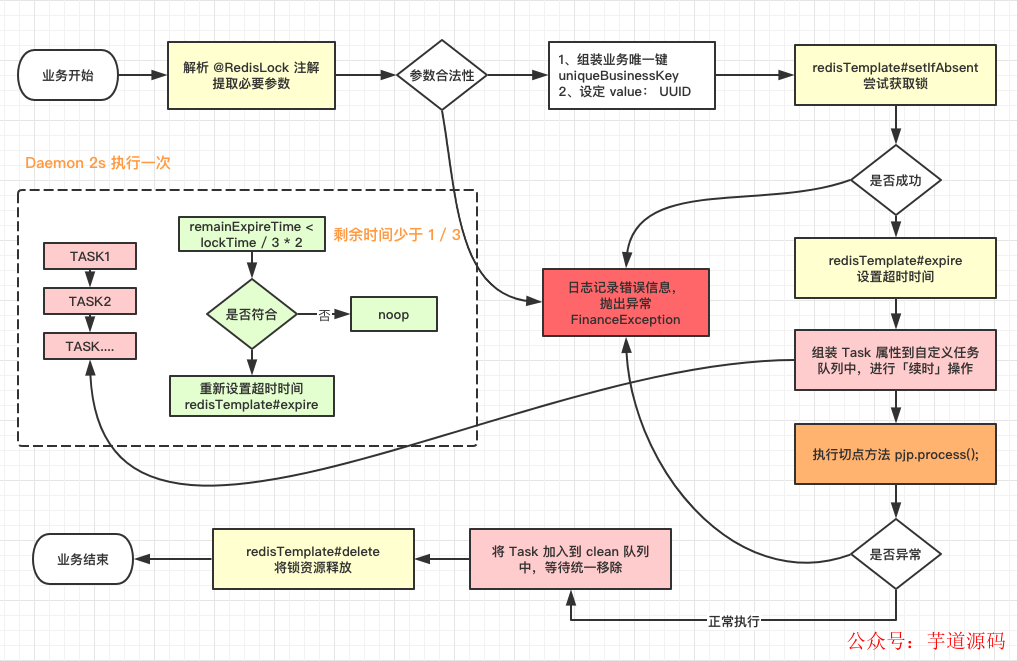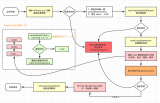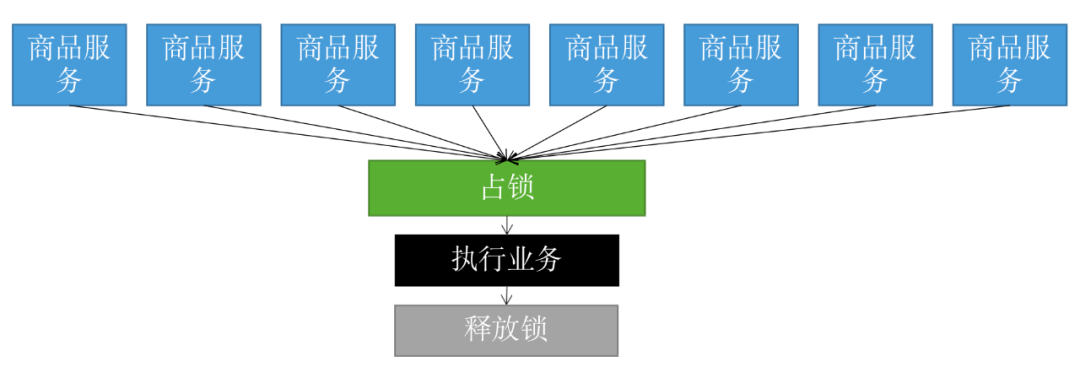一、業(yè)務(wù)背景
有些業(yè)務(wù)請(qǐng)求,屬于耗時(shí)操作,需要加鎖,防止后續(xù)的并發(fā)操作,同時(shí)對(duì)數(shù)據(jù)庫(kù)的數(shù)據(jù)進(jìn)行操作,需要避免對(duì)之前的業(yè)務(wù)造成影響。
基于 Spring Boot + MyBatis Plus + Vue & Element 實(shí)現(xiàn)的后臺(tái)管理系統(tǒng) + 用戶小程序,支持 RBAC 動(dòng)態(tài)權(quán)限、多租戶、數(shù)據(jù)權(quán)限、工作流、三方登錄、支付、短信、商城等功能
二、分析流程
使用 Redis 作為分布式鎖,將鎖的狀態(tài)放到 Redis 統(tǒng)一維護(hù),解決集群中單機(jī) JVM 信息不互通的問題,規(guī)定操作順序,保護(hù)用戶的數(shù)據(jù)正確。
梳理設(shè)計(jì)流程
新建注解 @interface,在注解里設(shè)定入?yún)?biāo)志
增加 AOP 切點(diǎn),掃描特定注解
建立 @Aspect 切面任務(wù),注冊(cè) bean 和攔截特定方法
特定方法參數(shù) ProceedingJoinPoint,對(duì)方法 pjp.proceed() 前后進(jìn)行攔截
切點(diǎn)前進(jìn)行加鎖,任務(wù)執(zhí)行后進(jìn)行刪除 key
核心步驟:加鎖、解鎖和續(xù)時(shí)
加鎖
使用了 RedisTemplate 的 opsForValue.setIfAbsent 方法,判斷是否有 key,設(shè)定一個(gè)隨機(jī)數(shù) UUID.random().toString,生成一個(gè)隨機(jī)數(shù)作為 value。
從 redis 中獲取鎖之后,對(duì) key 設(shè)定 expire 失效時(shí)間,到期后自動(dòng)釋放鎖。
按照這種設(shè)計(jì),只有第一個(gè)成功設(shè)定 Key 的請(qǐng)求,才能進(jìn)行后續(xù)的數(shù)據(jù)操作,后續(xù)其它請(qǐng)求由于無(wú)法獲得資源,將會(huì)失敗結(jié)束。
超時(shí)問題
擔(dān)心 pjp.proceed() 切點(diǎn)執(zhí)行的方法太耗時(shí),導(dǎo)致 Redis 中的 key 由于超時(shí)提前釋放了。
例如,線程 A 先獲取鎖,proceed 方法耗時(shí),超過(guò)了鎖超時(shí)時(shí)間,到期釋放了鎖,這時(shí)另一個(gè)線程 B 成功獲取 Redis 鎖,兩個(gè)線程同時(shí)對(duì)同一批數(shù)據(jù)進(jìn)行操作,導(dǎo)致數(shù)據(jù)不準(zhǔn)確。
解決方案:增加一個(gè)「續(xù)時(shí)」
任務(wù)不完成,鎖不釋放:
維護(hù)了一個(gè)定時(shí)線程池 ScheduledExecutorService,每隔 2s 去掃描加入隊(duì)列中的 Task,判斷是否失效時(shí)間是否快到了,公式為:【失效時(shí)間】<= 【當(dāng)前時(shí)間】+【失效間隔(三分之一超時(shí))】
/** *線程池,每個(gè)JVM使用一個(gè)線程去維護(hù)keyAliveTime,定時(shí)執(zhí)行runnable */ privatestaticfinalScheduledExecutorServiceSCHEDULER= newScheduledThreadPoolExecutor(1, newBasicThreadFactory.Builder().namingPattern("redisLock-schedule-pool").daemon(true).build()); static{ SCHEDULER.scheduleAtFixedRate(()->{ //dosomethingtoextendtime },0,2,TimeUnit.SECONDS); }
基于 Spring Cloud Alibaba + Gateway + Nacos + RocketMQ + Vue & Element 實(shí)現(xiàn)的后臺(tái)管理系統(tǒng) + 用戶小程序,支持 RBAC 動(dòng)態(tài)權(quán)限、多租戶、數(shù)據(jù)權(quán)限、工作流、三方登錄、支付、短信、商城等功能
三、設(shè)計(jì)方案
經(jīng)過(guò)上面的分析,同事小設(shè)計(jì)出了這個(gè)方案:

前面已經(jīng)說(shuō)了整體流程,這里強(qiáng)調(diào)一下幾個(gè)核心步驟:
攔截注解 @RedisLock,獲取必要的參數(shù)
加鎖操作
續(xù)時(shí)操作
結(jié)束業(yè)務(wù),釋放鎖
四、實(shí)操
之前也有整理過(guò) AOP 使用方法,可以參考一下
相關(guān)屬性類配置
業(yè)務(wù)屬性枚舉設(shè)定
publicenumRedisLockTypeEnum{
/**
*自定義key前綴
*/
ONE("Business1","Test1"),
TWO("Business2","Test2");
privateStringcode;
privateStringdesc;
RedisLockTypeEnum(Stringcode,Stringdesc){
this.code=code;
this.desc=desc;
}
publicStringgetCode(){
returncode;
}
publicStringgetDesc(){
returndesc;
}
publicStringgetUniqueKey(Stringkey){
returnString.format("%s:%s",this.getCode(),key);
}
}
任務(wù)隊(duì)列保存參數(shù)
publicclassRedisLockDefinitionHolder{
/**
*業(yè)務(wù)唯一key
*/
privateStringbusinessKey;
/**
*加鎖時(shí)間(秒s)
*/
privateLonglockTime;
/**
*上次更新時(shí)間(ms)
*/
privateLonglastModifyTime;
/**
*保存當(dāng)前線程
*/
privateThreadcurrentTread;
/**
*總共嘗試次數(shù)
*/
privateinttryCount;
/**
*當(dāng)前嘗試次數(shù)
*/
privateintcurrentCount;
/**
*更新的時(shí)間周期(毫秒),公式=加鎖時(shí)間(轉(zhuǎn)成毫秒)/3
*/
privateLongmodifyPeriod;
publicRedisLockDefinitionHolder(StringbusinessKey,LonglockTime,LonglastModifyTime,ThreadcurrentTread,inttryCount){
this.businessKey=businessKey;
this.lockTime=lockTime;
this.lastModifyTime=lastModifyTime;
this.currentTread=currentTread;
this.tryCount=tryCount;
this.modifyPeriod=lockTime*1000/3;
}
}
設(shè)定被攔截的注解名字
@Retention(RetentionPolicy.RUNTIME)
@Target({ElementType.METHOD,ElementType.TYPE})
public@interfaceRedisLockAnnotation{
/**
*特定參數(shù)識(shí)別,默認(rèn)取第0個(gè)下標(biāo)
*/
intlockFiled()default0;
/**
*超時(shí)重試次數(shù)
*/
inttryCount()default3;
/**
*自定義加鎖類型
*/
RedisLockTypeEnumtypeEnum();
/**
*釋放時(shí)間,秒s單位
*/
longlockTime()default30;
}
核心切面攔截的操作
RedisLockAspect.java 該類分成三部分來(lái)描述具體作用
Pointcut 設(shè)定
/**
*@annotation中的路徑表示攔截特定注解
*/
@Pointcut("@annotation(cn.sevenyuan.demo.aop.lock.RedisLockAnnotation)")
publicvoidredisLockPC(){
}
Around 前后進(jìn)行加鎖和釋放鎖
前面步驟定義了我們想要攔截的切點(diǎn),下一步就是在切點(diǎn)前后做一些自定義操作:
@Around(value="redisLockPC()")
publicObjectaround(ProceedingJoinPointpjp)throwsThrowable{
//解析參數(shù)
Methodmethod=resolveMethod(pjp);
RedisLockAnnotationannotation=method.getAnnotation(RedisLockAnnotation.class);
RedisLockTypeEnumtypeEnum=annotation.typeEnum();
Object[]params=pjp.getArgs();
StringukString=params[annotation.lockFiled()].toString();
//省略很多參數(shù)校驗(yàn)和判空
StringbusinessKey=typeEnum.getUniqueKey(ukString);
StringuniqueValue=UUID.randomUUID().toString();
//加鎖
Objectresult=null;
try{
booleanisSuccess=redisTemplate.opsForValue().setIfAbsent(businessKey,uniqueValue);
if(!isSuccess){
thrownewException("Youcan'tdoit,becauseanotherhasgetthelock=-=");
}
redisTemplate.expire(businessKey,annotation.lockTime(),TimeUnit.SECONDS);
ThreadcurrentThread=Thread.currentThread();
//將本次Task信息加入「延時(shí)」隊(duì)列中
holderList.add(newRedisLockDefinitionHolder(businessKey,annotation.lockTime(),System.currentTimeMillis(),
currentThread,annotation.tryCount()));
//執(zhí)行業(yè)務(wù)操作
result=pjp.proceed();
//線程被中斷,拋出異常,中斷此次請(qǐng)求
if(currentThread.isInterrupted()){
thrownewInterruptedException("Youhadbeeninterrupted=-=");
}
}catch(InterruptedExceptione){
log.error("Interruptexception,rollbacktransaction",e);
thrownewException("Interruptexception,pleasesendrequestagain");
}catch(Exceptione){
log.error("hassomeerror,pleasecheckagain",e);
}finally{
//請(qǐng)求結(jié)束后,強(qiáng)制刪掉key,釋放鎖
redisTemplate.delete(businessKey);
log.info("releasethelock,businessKeyis["+businessKey+"]");
}
returnresult;
}
上述流程簡(jiǎn)單總結(jié)一下:
解析注解參數(shù),獲取注解值和方法上的參數(shù)值
redis 加鎖并且設(shè)置超時(shí)時(shí)間
將本次 Task 信息加入「延時(shí)」隊(duì)列中,進(jìn)行續(xù)時(shí),方式提前釋放鎖
加了一個(gè)線程中斷標(biāo)志
結(jié)束請(qǐng)求,finally 中釋放鎖
續(xù)時(shí)操作
這里用了 ScheduledExecutorService,維護(hù)了一個(gè)線程,不斷對(duì)任務(wù)隊(duì)列中的任務(wù)進(jìn)行判斷和延長(zhǎng)超時(shí)時(shí)間:
//掃描的任務(wù)隊(duì)列 privatestaticConcurrentLinkedQueueholderList=newConcurrentLinkedQueue(); /** *線程池,維護(hù)keyAliveTime */ privatestaticfinalScheduledExecutorServiceSCHEDULER=newScheduledThreadPoolExecutor(1, newBasicThreadFactory.Builder().namingPattern("redisLock-schedule-pool").daemon(true).build()); { //兩秒執(zhí)行一次「續(xù)時(shí)」操作 SCHEDULER.scheduleAtFixedRate(()->{ //這里記得加try-catch,否者報(bào)錯(cuò)后定時(shí)任務(wù)將不會(huì)再執(zhí)行=-= Iterator iterator=holderList.iterator(); while(iterator.hasNext()){ RedisLockDefinitionHolderholder=iterator.next(); //判空 if(holder==null){ iterator.remove(); continue; } //判斷key是否還有效,無(wú)效的話進(jìn)行移除 if(redisTemplate.opsForValue().get(holder.getBusinessKey())==null){ iterator.remove(); continue; } //超時(shí)重試次數(shù),超過(guò)時(shí)給線程設(shè)定中斷 if(holder.getCurrentCount()>holder.getTryCount()){ holder.getCurrentTread().interrupt(); iterator.remove(); continue; } //判斷是否進(jìn)入最后三分之一時(shí)間 longcurTime=System.currentTimeMillis(); booleanshouldExtend=(holder.getLastModifyTime()+holder.getModifyPeriod())<=?curTime; ????????????if?(shouldExtend)?{ ????????????????holder.setLastModifyTime(curTime); ????????????????redisTemplate.expire(holder.getBusinessKey(),?holder.getLockTime(),?TimeUnit.SECONDS); ????????????????log.info("businessKey?:?["?+?holder.getBusinessKey()?+?"],?try?count?:?"?+?holder.getCurrentCount()); ????????????????holder.setCurrentCount(holder.getCurrentCount()?+?1); ????????????} ????????} ????},?0,?2,?TimeUnit.SECONDS); }
這段代碼,用來(lái)實(shí)現(xiàn)設(shè)計(jì)圖中虛線框的思想,避免一個(gè)請(qǐng)求十分耗時(shí),導(dǎo)致提前釋放了鎖。
這里加了「線程中斷」Thread#interrupt,希望超過(guò)重試次數(shù)后,能讓線程中斷 (未經(jīng)嚴(yán)謹(jǐn)測(cè)試,僅供參考哈哈哈哈)
不過(guò)建議如果遇到這么耗時(shí)的請(qǐng)求,還是能夠從根源上查找,分析耗時(shí)路徑,進(jìn)行業(yè)務(wù)優(yōu)化或其它處理,避免這些耗時(shí)操作。
所以記得多打點(diǎn) Log,分析問題時(shí)可以更快一點(diǎn)。
五、開始測(cè)試
在一個(gè)入口方法中,使用該注解,然后在業(yè)務(wù)中模擬耗時(shí)請(qǐng)求,使用了 Thread#sleep
@GetMapping("/testRedisLock")
@RedisLockAnnotation(typeEnum=RedisLockTypeEnum.ONE,lockTime=3)
publicBooktestRedisLock(@RequestParam("userId")LonguserId){
try{
log.info("睡眠執(zhí)行前");
Thread.sleep(10000);
log.info("睡眠執(zhí)行后");
}catch(Exceptione){
//logerror
log.info("hassomeerror",e);
}
returnnull;
}
使用時(shí),在方法上添加該注解,然后設(shè)定相應(yīng)參數(shù)即可,根據(jù) typeEnum 可以區(qū)分多種業(yè)務(wù),限制該業(yè)務(wù)被同時(shí)操作。
測(cè)試結(jié)果:
2020-04-0414:55:50.864INFO9326---[nio-8081-exec-1]c.s.demo.controller.BookController:睡眠執(zhí)行前 2020-04-0414:55:52.855INFO9326---[k-schedule-pool]c.s.demo.aop.lock.RedisLockAspect:businessKey:[Business1:1024],trycount:0 2020-04-0414:55:54.851INFO9326---[k-schedule-pool]c.s.demo.aop.lock.RedisLockAspect:businessKey:[Business1:1024],trycount:1 2020-04-0414:55:56.851INFO9326---[k-schedule-pool]c.s.demo.aop.lock.RedisLockAspect:businessKey:[Business1:1024],trycount:2 2020-04-0414:55:58.852INFO9326---[k-schedule-pool]c.s.demo.aop.lock.RedisLockAspect:businessKey:[Business1:1024],trycount:3 2020-04-0414:56:00.857INFO9326---[nio-8081-exec-1]c.s.demo.controller.BookController:hassomeerror java.lang.InterruptedException:sleepinterrupted atjava.lang.Thread.sleep(NativeMethod)[na:1.8.0_221]
我這里測(cè)試的是重試次數(shù)過(guò)多,失敗的場(chǎng)景,如果減少睡眠時(shí)間,就能讓業(yè)務(wù)正常執(zhí)行。
如果同時(shí)請(qǐng)求,你將會(huì)發(fā)現(xiàn)以下錯(cuò)誤信息:

表示我們的鎖的確生效了,避免了重復(fù)請(qǐng)求。
六、總結(jié)
對(duì)于耗時(shí)業(yè)務(wù)和核心數(shù)據(jù),不能讓重復(fù)的請(qǐng)求同時(shí)操作數(shù)據(jù),避免數(shù)據(jù)的不正確,所以要使用分布式鎖來(lái)對(duì)它們進(jìn)行保護(hù)。
再來(lái)梳理一下設(shè)計(jì)流程:
新建注解 @interface,在注解里設(shè)定入?yún)?biāo)志
增加 AOP 切點(diǎn),掃描特定注解
建立 @Aspect 切面任務(wù),注冊(cè) bean 和攔截特定方法
特定方法參數(shù) ProceedingJoinPoint,對(duì)方法 pjp.proceed() 前后進(jìn)行攔截
切點(diǎn)前進(jìn)行加鎖,任務(wù)執(zhí)行后進(jìn)行刪除 key
本次學(xué)習(xí)是通過(guò) Review 小伙伴的代碼設(shè)計(jì),從中了解分布式鎖的具體實(shí)現(xiàn),仿照他的設(shè)計(jì),重新寫了一份簡(jiǎn)化版的業(yè)務(wù)處理。對(duì)于之前沒考慮到的「續(xù)時(shí)」操作,這里使用了守護(hù)線程來(lái)定時(shí)判斷和延長(zhǎng)超時(shí)時(shí)間,避免了鎖提前釋放。
于是乎,同時(shí)回顧了三個(gè)知識(shí)點(diǎn):
1、AOP 的實(shí)現(xiàn)和常用方法
2、定時(shí)線程池 ScheduledExecutorService 的使用和參數(shù)含義
3、線程 Thread#interrupt 的含義以及用法(這個(gè)挺有意思的,可以深入再學(xué)習(xí)一下)
-
spring
+關(guān)注
關(guān)注
0文章
338瀏覽量
14311 -
Redis
+關(guān)注
關(guān)注
0文章
371瀏覽量
10846
原文標(biāo)題:Spring Boot加一個(gè)注解,輕松實(shí)現(xiàn) Redis 分布式鎖
文章出處:【微信號(hào):芋道源碼,微信公眾號(hào):芋道源碼】歡迎添加關(guān)注!文章轉(zhuǎn)載請(qǐng)注明出處。
發(fā)布評(píng)論請(qǐng)先 登錄
相關(guān)推薦
redis分布式鎖場(chǎng)景實(shí)現(xiàn)
在 Java 中利用 redis 實(shí)現(xiàn)一個(gè)分布式鎖服務(wù)
Redis 分布式鎖的正確實(shí)現(xiàn)方式
如何使用注解實(shí)現(xiàn)redis分布式鎖!





 Spring Boot實(shí)現(xiàn)Redis分布式鎖
Spring Boot實(shí)現(xiàn)Redis分布式鎖











評(píng)論